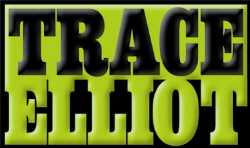Trace Elliot
 | |
| Industry | Audio equipment |
|---|---|
| Founded | 1979 |
| Parent | Peavey Electronics Europe, Ltd |
| Website | http://www.traceelliot.com |
Trace Elliot is a United Kingdom-based bass amplification manufacturer, and has a sub-brand, Trace Acoustic, for acoustic instruments.
History
In 1979, a music shop in Romford, Essex, UK, called Soundwave was building and hiring out PA systems to local musicians. It soon became apparent that some of this equipment was not being used simply as PA but instead was being used by bass players, who for so long had to put up with under-powered amplification that was often merely a guitar amplifier with a modified tone circuit.
The Soundwave owner and staff realised the potential market and developed a range of products that incorporated MOSFET output stages driving large cabinets, including 15” drivers, and also the worlds first bass-dedicated 4 x 10” cabinet, now an industry standard for all bass amp lines.
Trace Elliot, as the brand came to be called, gained a reputation for themselves; rumor has it that early users were John Paul Jones of Led Zeppelin and Brian Helicopter of punk band The Shapes. Mark King of Level 42 was also an early adopter of the brand.[1] The company, now dedicated to manufacturing, moved to new premises in Witham, Essex, in 1985 to satisfy the growing demand. In that same year Fred Friedlein (then sole owner of Trace Elliot) employed the services of freelance electronics designer Clive Button.
In 1989, Trace Elliot introduced the Trace Acoustic range of acoustic amplifiers (also designed by Clive Button), and the company moved again, this time to Maldon, Essex. In 1992 the company was bought by Kaman, which had previously handled the brand's US distribution.
Kaman downsized their music division in 1997 and sold the company to a trio of Trace Elliot directors, who took ownership of a brand with nearly 200 staff on a 110,000-square-foot (10,000 m2) site; they focused on exploiting the North American market, and in 1998 sold the company to the Gibson Guitar Corporation.[2]
However, in January 2002, the factory was closed and all staff were made redundant. Gibson then moved the production of a few particular products they wanted to continue with to various locations in the United States.
In April 2005 it was announced that Peavey Electronics already employing previous Trace Elliot director Clive Roberts, acquired the brand name and were involving previous Trace Elliot designer Paul Stevens as electronics designer.
Notable products, past and present
- GP11 pre-amplifier, very collectable unit combined with various power amp models produced in 1980s.
- 1048H Successor to the world's first dedicated 4 x 10” bass cabinet.
- AH1000-12 Fully featured bass head with 12 Band EQ, Valve Drive, dual band compression and many other features.
- Trace Acoustic range. Numerous models for amplifying acoustic instruments.
- GP12SMX Bass Preamp: 12 Band EQ Bass Pre-amp. The basis for the preamp in all the SMX series.
- V-Type V6 300 watt all valve head. Used by many Britpop bands in the '90s.
- V-Type V8 400 watt all valve head, with overdrive and compression on board.
- Velocette: 1990s-era 15W valve-powered guitar combos; several variants, basis for the Gibson Goldtone range.
References
- ↑ "Product line summary". Mahogany. 2006. Archived from the original on 2007-02-07. Retrieved 2007-06-16.). ("Pro Audio Company Names: Mysterious Initials -- What They Mean". Rane Corporation. 2007-02-15. Retrieved 2007-06-16.
- ↑ "Gibson Labs Amp Academy Session 3". Gibson Labs. Retrieved 2006-06-16.